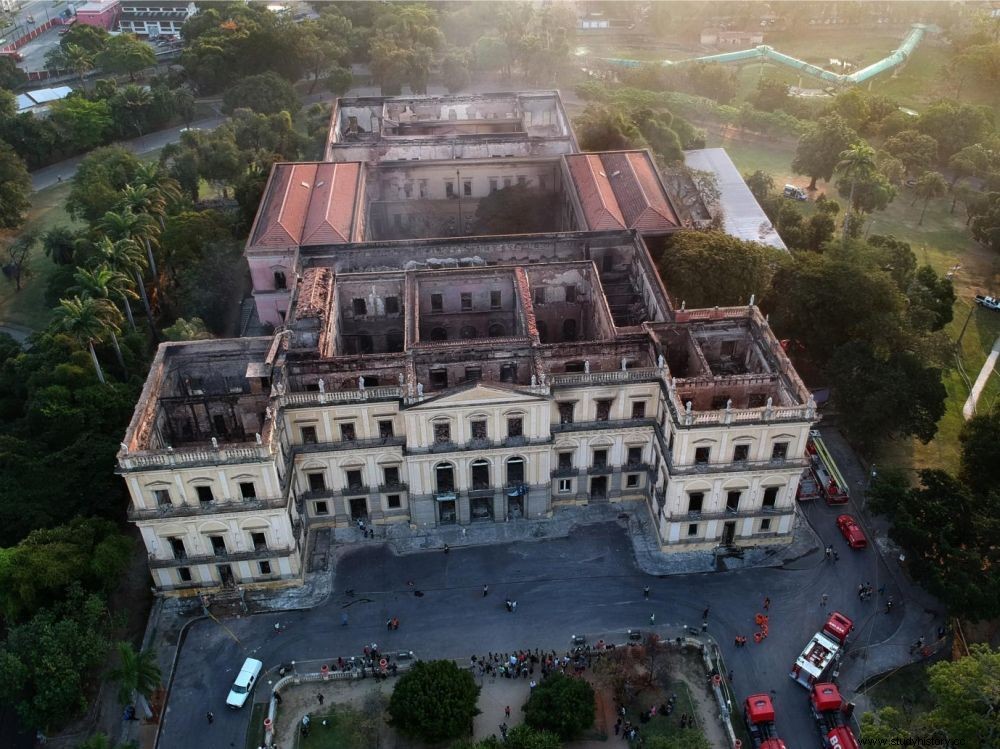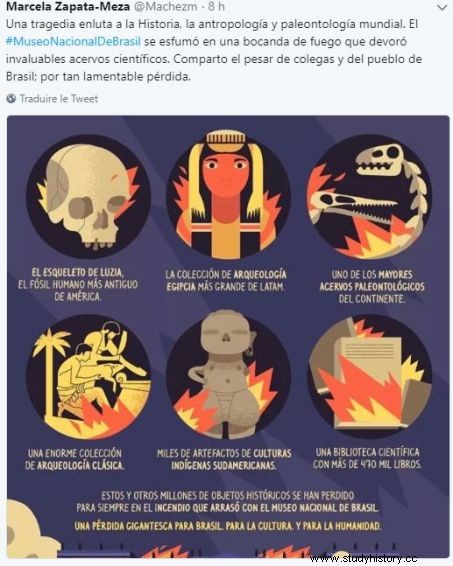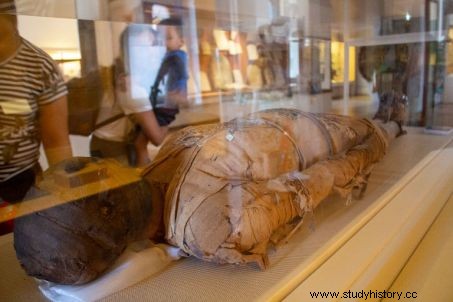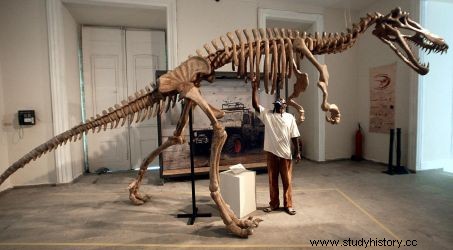On the night of September 2 to 3, 2018, a fire ravaged the National Museum of Rio de Janeiro (Brazil), one of the largest museums on the American continent. A look back at the lost collections… and what would have survived…

Aerial view of the National Museum of Rio de Janeiro (Brazil), the day after the fire from September 2 to 3, 2018.
Tristeza nao tem fim ("Sadness has no end")… * Brazil has just been hit to the heart by the fire that ravaged the National Museum of Rio de Janeiro on the night of September 2 to 3, 2018. The flames completely destroyed this national treasure which housed more than 20 million pieces and had just celebrated its 200th anniversary last June. Unique collections in the world patiently built up since the 18th century, gathered in the old palace of the magnificent park of Quinta da Boa Vista , north of the carioca city. "It's an incalculable loss" , declared to the press Michel Temer, the current Brazilian president today in the turmoil of an emerging controversy.
A collapsed roof, charred walls, .. what remains of the National Museum of Rio de Janeiro (Brazil). Credits:Mauro Pimentel/AFP
Founded on June 6, 1818 by King John VI of Portugal (Dom Joao VI), the National Museum of Rio had been housed in the Saint-Christophe Palace where the Portuguese and Brazilian royal families resided throughout the 19th century. Inside the many rooms were exhibited collections of geology, paleontology, botany, anthropology, or even ethnology and archeology.
Infographic of the missing collections reproduced by the BBC. Credits:Marcela Zapata-Meza
Among the iconic objects was the oldest human fossil on the South American continent, the famous "Luzia (11,500 years old) discovered in the region of Lagoa Santa, in the state of Minas Gerais.

Or a throne of the king of Dahomey offered to Dom Joao VI (1767-1826). Without forgetting important Egyptian antiquities. "The Egyptian collection of the Rio Museum was the largest in Latin America, explains Egyptologist Pascal Vernus, director of studies at the Ecole Pratique des Hautes Etudes (EPHE) in Paris, interviewed by Sciences et Avenir. A good part had been bought before 1844. It knew many tribulations because it was originally intended for the Museum of Buenos Aires (Argentina). Nicolau Fiengo, an Italian had sold a collection constituted by Giovanni Battista Belzoni to King Dom Pedro I" .
One of the Egyptian mummies kept in the Department of Antiquities of the National Museum of Rio de Janeiro (Brazil). Credits:Rui Porto Filho /AFP
This included more than twenty stelae and bas-reliefs from the Middle Kingdom, New Kingdom and Late Period. "It also included demotic papyri, sarcophagi, mummies, as well as a quantity of funerary furniture (ushebti, canopic jars, etc) , continues the researcher. The National Museum also kept rich Amerindian collections from pre-Columbian times, and Andean mummies. As for the Brazilian archeology collection, as one can easily imagine, it brought together a wide range of objects made by the hunter-gatherer peoples who inhabited the Brazilian territory since prehistoric times. The same applies to ethnological collections from all indigenous groups in Brazil. Including audio recordings of now extinct languages...
Attached to the Federal University of Rio de Janeiro (UFRJ), the national museum was also the oldest scientific institution in the country and housed research centers. It thus held the largest collection of natural history and anthropology in Latin America. Many European naturalists had come to work there in the 19th century, like the famous Johann Baptiste von Spix and Carl Friedrich Philipp von Martius, the "Lewis and Clark" of Brazil, who had collected natural and ethnological specimens during expeditions of several years conducted across the country.
Also rich were the fossil treasures of this museum with the skeletons of several dinosaurs, flying reptiles and crocodilians.
One of the dinosaur skeletons (Suchomimus) disappeared in the fire. Credits:Vanderlei Almeida /AFP
Faced with this disaster, Luis Fernando Duarte, deputy director of the institution, denounced the "lack of support and lack of awareness " of public power that led to this "tragic situation ". "We have fought for years, under different governments, for resources to adequately preserve all that has been destroyed today" , he was indignant in the pages of the Guardian . Like most Brazilian scientific institutions, the museum had indeed been the victim of successive budget cuts, including closure, in 2015, because the staff could no longer be paid. This tragedy - the exact reasons for which are still not established at this time - has also triggered reactions from foreign researchers who again point to the urgency, for all major institutions around the world, to shelter museum objects thanks to their digitization. "The fire at the Rio museum certainly shows the lack of resources for the maintenance and general operation of such establishments, but it highlights the challenge of digitizing written documents as well as ethnographic and archaeological pieces. Many museums are not immune!" , estimated Christophe Moulherat, in charge of analysis of the Collections at the Quai Branly museum, in Paris, who frequently visits South American museums.
However, -the worst is never certain-, information reported by the site Globo News and the daily La Folha de Sao Paulo reported that "herbariums of the museum, its main library, part of the zoology (invertebrates) collection - preserved in an annex building-, as well as minerals and meteorites, including one of 5 tons, one of the largest in the world, discovered in Bendego, in the sertao of the State of Bahia, in 1784", would have been spared.
Meteorite that survived the fire in the National Museum of Rio de Janeiro (Brazil).
The tragedy of the National Museum of Rio recalls other misfortunes suffered by Brazil in the field of science and culture. Forty years ago, on July 8, 1978, the Museum of Modern Art in Rio saw a thousand works of art disappear in the flames, including paintings by Pablo Picasso and Salvador Dali. And in 2003, more dramatically still, 21 engineers were killed in the explosion of a rocket which had pulverized the base of Alcantara (North-East), destroying the aerospace ambitions of the country.
The National Museum of Rio de Janeiro, before the fire.
With the disappearance of the National Museum, it is therefore part of the heritage, but also of the historical, cultural and scientific memory of Brazil that has just gone up in smoke. Ironically, as Brazil prepares to commemorate its Independence Day on September 7, 2018, it is within the still burning walls of this museum, witnesses to great moments in Brazilian history, that signed this proclamation in 1822…
* opening lyrics of a famous song by Carlos Jobim and Vinicius de Moraes.






